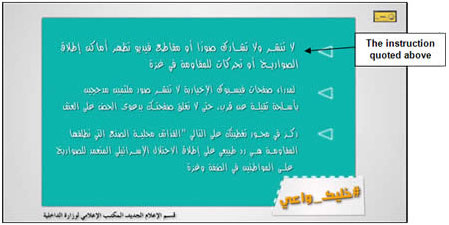Source: ITIC report
Hamas' media policy forged during Operation Protective Edge restricts local and foreign correspondents covering the fighting in their reports on military-combat activity or military-related information (especially regarding rocket fire and the use of civilians as human shields). During the operation, foreign and local correspondents followed Hamas' policy guidelines, for the most part, and mainly reported on the suffering of the local population and other civilian aspects of the fighting.
During the first days of Operation Protective Edge, Hamas established a policy for media reports to be implemented by local and foreign correspondents covering the fighting. Its objectives were to prevent reports that would prove Israel's claims of Hamas use of Gazan civilians as human shields, and to reinforce the propaganda theme that Israel deliberately attacked civilians and committed "war crimes." As a result, during the first days of the fighting the information bureau of the Hamas-controlled ministry of the interior in Gaza issued instructions on how the social networks in the Gaza Strip were to report events (YouTube, July 10, 2014).
Instruction number five read, "Do not publicize
[information about] and do not share pictures or video clips showing
rocket launching sites or the movement of resistance [operatives] in
Gaza." Those responsible for news pages on Facebook were told "don't use
close-ups of heavily armed masked operatives, otherwise your Facebook
page will be closed for incitement to violence."

Hamas issued similar instructions to correspondents in other ways. For example, the Palestinian Journalist Bloc, a media group in the Gaza Strip affiliated with Hamas, instructed the media and correspondents in the Gaza Strip not to photograph or publicize information about rockets fired by military-terrorist operatives belonging to the various organizations so as not to play into the hands of Israeli public diplomacy (Hamas' Al-Aqsa TV, July 8, 2014).
The local and foreign media reports generally followed Hamas policy. They emphasized civilian suffering, the many civilian casualties and the increasing humanitarian distress, while severely criticizing Israel's conduct. On the other hand, reports of the military aspects of the fighting and the sensitive issue of the use of the civilian population as human shields received relatively scant coverage.
A foreign correspondent, who preferred to remain anonymous, told Yedioth Aharonoth's Daniel Batini (August 7, 2014) that "First, Hamas said its spokesmen could only be interviewed in the courtyard of the Al-Shifa'a Hospital in Gaza City. That meant there were long lines of correspondents waiting for interviews, and as a result they watched the bleeding wounded arriving at the hospital for treatment. That [system] created exactly the impression Hamas wanted, of an immediate emergency situation and a human and humanitarian catastrophe. Second, Hamas never allowed foreign correspondents access to military sites attacked by Israel, whether they were bases, rocket launching sites or other targets. The organization's dead and wounded operatives were not photographed and therefore, from a media point of view, they do not exist. All that serves Hamas' objective of representing all the casualties as civilians. Third, it was obvious that Hamas was firing rockets from civilian areas, but Hamas operatives forbid camera teams from filming them, because they did not want to reveal the tactic or the locations of the launch sites." (ITIC translation from Hebrew and emphasis)